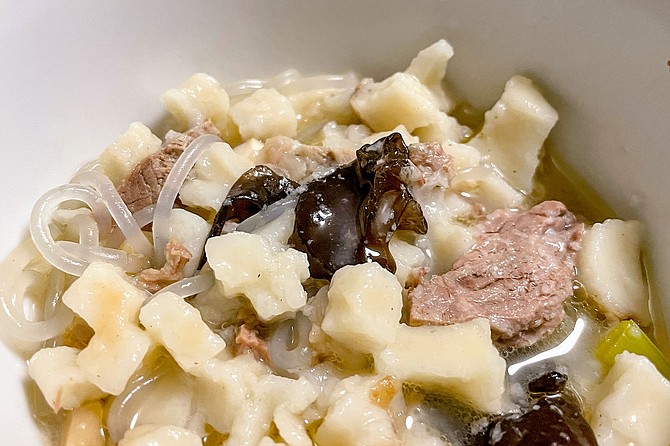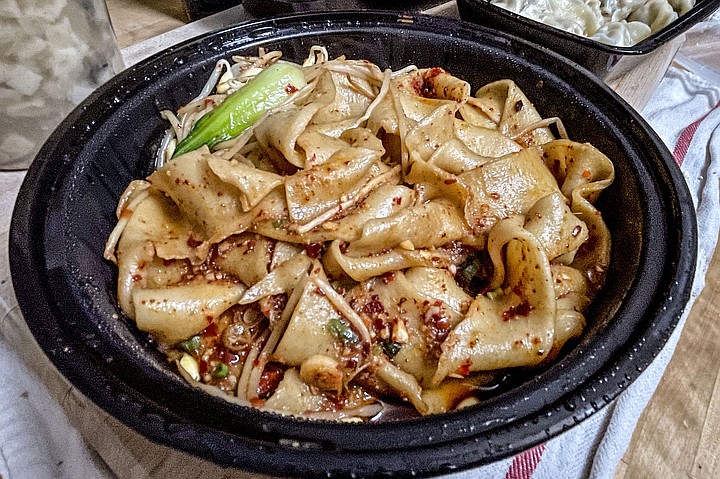 Facebook
Facebook
 X
X
 Instagram
Instagram
 TikTok
TikTok
 Youtube
Youtube

I’m always on the lookout for a new kind of soup to try, and yet for some reason I’m always surprised when I find one.
What’s not surprising is that most of the unfamiliar soup styles I do encounter are being served by restaurants that serve cultural cuisines. I can clearly recall learning what the chicken and vegetable tlalpeño is, at El Comal in North Park, which also introduced me to my now beloved spicy hominy soup pozole. I can credit a pair of Convoy Street restaurants for showing me the joy of a pair of Korean soups: the bone brothy seolleongtang of Woomiok, and Convoy Tofu House’s sundubu-jjigae, a soft tofu stew I now crave every winter.
It was likewise in Kearny Mesa that I discovered my latest soup obsession: pao-mo.
This wasn’t my first time visiting Shan Xi Magic Kitchen, where it’s super easy to overlook any soup thanks to the restaurant’s practice of making hand-pulled noodles. For example the thick, two-foot-long ribbons making up Shan Xi’s bianbiang noodles. Simply prepared with chili flakes, oil, vinegar, and sprouted mung beans, the dish is a classic from the Shaanxi province of northern China that gives this restaurant its name.
As I pored over its take-out menu at home, I was on the lookout for Shaanxi-specific dishes, hoping to learn more about one of China’s lesser-known regional cuisines. That little internet research is how I lucked into the pao-mo.
It’s really more of a stew of lamb, prepared here with glass noodles and mushrooms. But the real key to the stuff is a whole lot of heavy, chopped-up bread thickening up the dish, and soaking up lamb broth.
Reading about it, I was initially surprised to see bread-featured soup at all, never mind a Chinese dish. And I couldn’t quite comprehend how filling a soup with bread could even work — like, wouldn’t the bread simply disintegrate into the stock?

It all became clearer once I served myself a bowl. The small cubes of bread filling the stew are thick and dense — each bite reminds me more of the boiled biscuit dough my grandmother made into her chicken and dumplings. They’re soft yet chewy, moist but not completely soaked through, so the middle is almost dry by comparison.
There’s not a whole lot of lamb in the Magic Kitchen’s preparation, and not a lot of broth for that matter. But it’s all just enough to support those chewy bread dumplings. And though I’d never met a pao-mo before in my life, it ate like comfort food, like something I’d always known about, somewhere deep inside.


I’m always on the lookout for a new kind of soup to try, and yet for some reason I’m always surprised when I find one.
What’s not surprising is that most of the unfamiliar soup styles I do encounter are being served by restaurants that serve cultural cuisines. I can clearly recall learning what the chicken and vegetable tlalpeño is, at El Comal in North Park, which also introduced me to my now beloved spicy hominy soup pozole. I can credit a pair of Convoy Street restaurants for showing me the joy of a pair of Korean soups: the bone brothy seolleongtang of Woomiok, and Convoy Tofu House’s sundubu-jjigae, a soft tofu stew I now crave every winter.
It was likewise in Kearny Mesa that I discovered my latest soup obsession: pao-mo.
This wasn’t my first time visiting Shan Xi Magic Kitchen, where it’s super easy to overlook any soup thanks to the restaurant’s practice of making hand-pulled noodles. For example the thick, two-foot-long ribbons making up Shan Xi’s bianbiang noodles. Simply prepared with chili flakes, oil, vinegar, and sprouted mung beans, the dish is a classic from the Shaanxi province of northern China that gives this restaurant its name.
As I pored over its take-out menu at home, I was on the lookout for Shaanxi-specific dishes, hoping to learn more about one of China’s lesser-known regional cuisines. That little internet research is how I lucked into the pao-mo.
It’s really more of a stew of lamb, prepared here with glass noodles and mushrooms. But the real key to the stuff is a whole lot of heavy, chopped-up bread thickening up the dish, and soaking up lamb broth.
Reading about it, I was initially surprised to see bread-featured soup at all, never mind a Chinese dish. And I couldn’t quite comprehend how filling a soup with bread could even work — like, wouldn’t the bread simply disintegrate into the stock?

It all became clearer once I served myself a bowl. The small cubes of bread filling the stew are thick and dense — each bite reminds me more of the boiled biscuit dough my grandmother made into her chicken and dumplings. They’re soft yet chewy, moist but not completely soaked through, so the middle is almost dry by comparison.
There’s not a whole lot of lamb in the Magic Kitchen’s preparation, and not a lot of broth for that matter. But it’s all just enough to support those chewy bread dumplings. And though I’d never met a pao-mo before in my life, it ate like comfort food, like something I’d always known about, somewhere deep inside.
Comments